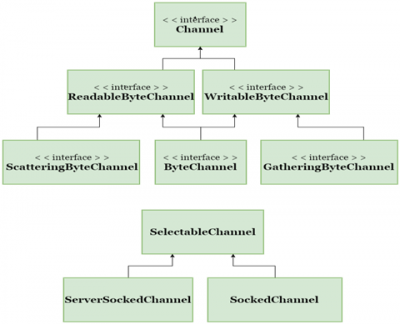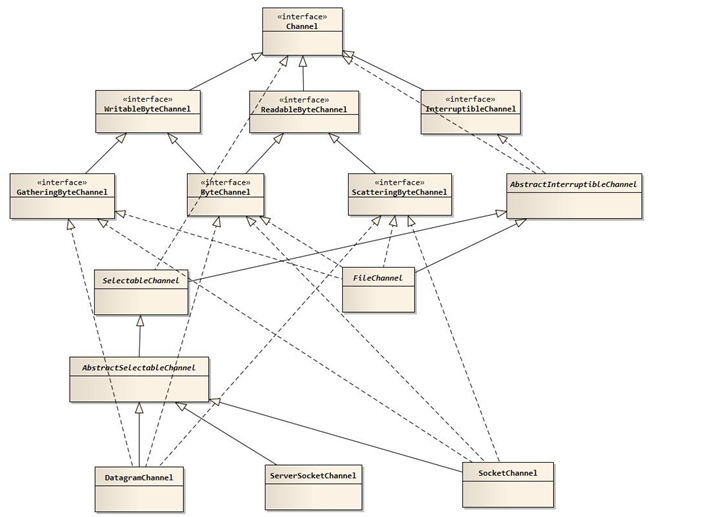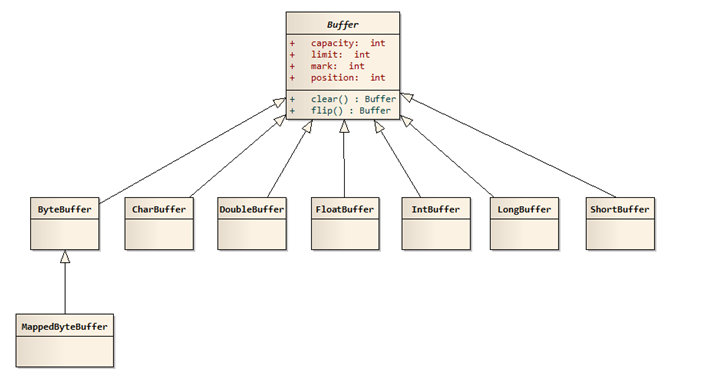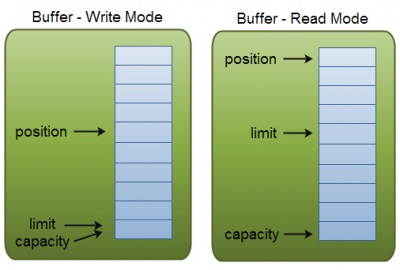“关于NIO”的版本间差异
(→其他) |
|||
| (未显示同一用户的16个中间版本) | |||
| 第2行: | 第2行: | ||
== 关于 == | == 关于 == | ||
Java NIO,即“'''New I/O''' | Java NIO,即“'''New I/O'''”<s>(另一说“'''No-Blocking I/O'''”)</s>:采用'''内存映射文件'''的方式来处理输入输出:NIO将文件或文件的一段区域映射到内存中,这样就可以像访问内存一样访问文件了。 | ||
*(相关内容:[http://tutorials.jenkov.com/java-nio/index.html?spm=a2c6h.12873639.0.0.3e1ba7fdKRM8ja Java NIO Tutorial],网上资料大多来自于此) | *(相关内容:[http://tutorials.jenkov.com/java-nio/index.html?spm=a2c6h.12873639.0.0.3e1ba7fdKRM8ja Java NIO Tutorial],网上资料大多来自于此) | ||
* 此 NIO,意为'''Java的“New IO API”''',而非“No-Blocking I/O”模型。 | |||
=== 与 IO === | === 与 IO === | ||
| 第52行: | 第53行: | ||
==【IO:同步、异步,阻塞、非阻塞】== | ==【IO:同步、异步,阻塞、非阻塞】== | ||
* 见: | |||
** '''“[[关于:5种I/O模型]]”''' | |||
** '''“[[关于:Java网络IO编程(BIO、NIO、AIO)]]”''' | |||
== NIO 组件 == | == NIO 组件 == | ||
| 第76行: | 第79行: | ||
“java.nio.channels”类的层次结构: | “java.nio.channels”类的层次结构: | ||
: [[File:java.nio.channels类的层次结构.png|400px]] | : [[File:java.nio.channels类的层次结构.png|400px]] | ||
: [[File:Java NIO:Channel类结构.png|800px]] | |||
其中顶层接口: | 其中顶层接口: | ||
<syntaxhighlight lang="java"> | <syntaxhighlight lang="java"> | ||
| 第124行: | 第128行: | ||
Java NIO中的Buffer用于和NIO通道进行交互: | Java NIO中的Buffer用于和NIO通道进行交互: | ||
: 缓冲区本质上是一块可以写入数据,然后可以从中读取数据的内存。这块内存被包装成NIO Buffer对象,并提供了一组方法,用来方便的访问该块内存。 | : 缓冲区本质上是一块可以写入数据,然后可以从中读取数据的内存。这块内存被包装成NIO Buffer对象,并提供了一组方法,用来方便的访问该块内存。 | ||
:[[File:java.nio.Buffer类结构.png|300px]] | : [[File:java.nio.Buffer类结构.png|300px]] | ||
: [[File:Java NIO:Buffer类结构.png|800px]] | |||
在Java NIO中使用的核心缓冲区如下: | 在Java NIO中使用的核心缓冲区如下: | ||
* '''ByteBuffer''' | * '''ByteBuffer''' | ||
| 第225行: | 第230行: | ||
=== Selector === | === Selector === | ||
Selector(选择器)是Java NIO中能够检测一到多个NIO通道,并能够知晓通道是否为诸如读写事件做好准备的组件。简而言之:“'''<big>使用单个线程处理多个通道</big>'''”。 | |||
:[[File:NIO:Selector.png|300px]] | |||
* 这样,一个单独的线程可以管理多个channel,从而管理多个网络连接。【对于操作系统来说,线程之间上下文切换的开销很大,而且每个线程都要占用系统的一些资源(如内存),因此,使用的线程越少越好。(事实上,可以只用一个线程处理所有的通道)】 | |||
*:(但是,现代的操作系统和CPU在多任务方面表现的越来越好,多线程的开销也变得越来越小了。实际上,如果一个CPU有多个内核,不使用多任务可能是在浪费CPU能力) | |||
==== SelectionKey ==== | |||
当向Selector注册Channel时,“register()”方法会返回一个“'''SelectionKey'''”对象。这个对象包含了一些你感兴趣的属性: | |||
* '''interest集合''':interest集合是你所选择的感兴趣的事件集合。 | |||
*: 可以通过SelectionKey读写interest集合: | |||
*: <syntaxhighlight lang="java"> | |||
int interestSet = selectionKey.interestOps(); | |||
</syntaxhighlight> | |||
*: 用“位与”操作interest集合和给定的SelectionKey常量,可以确定某个确定的事件是否在interest集合中: | |||
*: <syntaxhighlight lang="java"> | |||
boolean isInterestedInAccept = (interestSet & SelectionKey.OP_ACCEPT) == SelectionKey.OP_ACCEPT; | |||
boolean isInterestedInConnect = interestSet & SelectionKey.OP_CONNECT; | |||
boolean isInterestedInRead = interestSet & SelectionKey.OP_READ; | |||
boolean isInterestedInWrite = interestSet & SelectionKey.OP_WRITE; | |||
</syntaxhighlight> | |||
* '''ready集合''':ready 集合是通道已经准备就绪的操作的集合。 | |||
*: 在一次选择(Selection)之后,你会首先访问这个ready set: | |||
*: <syntaxhighlight lang="java"> | |||
int readySet = selectionKey.readyOps(); | |||
</syntaxhighlight> | |||
*: 也可以使用以下四个方法,检测channel中什么事件或操作已经就绪,它们都会返回一个布尔类型: | |||
*: <syntaxhighlight lang="java"> | |||
selectionKey.isAcceptable(); | |||
selectionKey.isConnectable(); | |||
selectionKey.isReadable(); | |||
selectionKey.isWritable(); | |||
</syntaxhighlight> | |||
* '''Channel''': | |||
*: 从SelectionKey访问Channel: | |||
*: <syntaxhighlight lang="java"> | |||
Channel channel = selectionKey.channel(); | |||
</syntaxhighlight> | |||
* '''Selector''': | |||
*: 从SelectionKey访问Selector: | |||
*: <syntaxhighlight lang="java"> | |||
Selector selector = selectionKey.selector(); | |||
</syntaxhighlight> | |||
* 附加的对象(可选):可以将一个对象或者更多信息附着到SelectionKey上,这样就能方便的识别某个给定的通道。 | |||
*: 例如,可以附加 与通道一起使用的Buffer,或是包含聚集数据的某个对象。使用方法如下: | |||
*: <syntaxhighlight lang="java"> | |||
selectionKey.attach(theObject); | |||
Object attachedObj = selectionKey.attachment(); | |||
</syntaxhighlight> | |||
*: 还可以在用register()方法向Selector注册Channel的时候附加对象。如: | |||
*: <syntaxhighlight lang="java"> | |||
SelectionKey key = channel.register(selector, SelectionKey.OP_READ, theObject); | |||
</syntaxhighlight> | |||
==== Selector使用 ==== | |||
# '''Selector的创建''':通过调用“Selector.open()”方法创建一个Selector: | |||
#: <syntaxhighlight lang="java"> | |||
Selector selector = Selector.open(); | |||
</syntaxhighlight> | |||
# '''向Selector注册通道''':通过“SelectableChannel.register()”方法来实现: | |||
#: 为了将Channel和Selector配合使用,必须将channel注册到selector上。 | |||
#: <syntaxhighlight lang="java"> | |||
channel.configureBlocking(false); // 与Selector一起使用时,Channel必须处于非阻塞模式下。 | |||
SelectionKey key = channel.register(selector, Selectionkey.OP_READ); | |||
</syntaxhighlight> | |||
#* 与Selector一起使用时,'''Channel必须处于非阻塞模式'''下。这意味着'''不能将FileChannel与Selector一起使用''',因为FileChannel不能切换到非阻塞模式。而套接字通道都可以。 | |||
#* 注意register()方法的第二个参数。这是一个“interest集合”,意思是在通过Selector监听Channel时对什么事件感兴趣。可以监听四种不同类型的事件: | |||
#** '''Connect'''—对应“SelectionKey”常量—'''SelectionKey.OP_CONNECT''' | |||
#** '''Accept'''—对应“SelectionKey”常量—'''SelectionKey.OP_ACCEPT''' | |||
#** '''Read'''—对应“SelectionKey”常量—'''SelectionKey.OP_READ''' | |||
#** '''Write'''—对应“SelectionKey”常量—'''SelectionKey.OP_WRITE''' | |||
#*: 通道触发了一个事件意思是该事件已经就绪:某个channel成功连接到另一个服务器称为“连接就绪”。一个server socket channel准备好接收新进入的连接称为“接收就绪”。一个有数据可读的通道可以说是“读就绪”。等待写数据的通道可以说是“写就绪”。 | |||
#*: 如果你对不止一种事件感兴趣,那么可以用“位或”操作符将常量连接起来,如下: | |||
#*: <syntaxhighlight lang="java"> | |||
int interestSet = SelectionKey.OP_READ | SelectionKey.OP_WRITE; | |||
</syntaxhighlight> | |||
# '''通过Selector选择通道''':一旦向Selector注册了一或多个通道,就可以调用几个重载的“select()方法”。这些方法返回你所感兴趣的事件(如连接、接受、读或写)已经准备就绪的那些通道: | |||
#* “int select()”:阻塞到至少有一个通道在你注册的事件上就绪了。 | |||
#* “int select(long timeout)”:和select()一样,除了最长会阻塞timeout毫秒(参数)。 | |||
#* “int selectNow()”:不会阻塞,不管什么通道就绪都立刻返回。(如果自从前一次选择操作后,没有通道变成可选择的,则此方法直接返回零) | |||
#*: 返回的int值表示有多少通道已经就绪。亦即,“'''自上次调用select()方法后有多少通道变成就绪状态'''”。【如果调用select()方法,因为有一个通道变成就绪状态,返回了1,若再次调用select()方法,如果另一个通道就绪了,它会再次返回1。如果对第一个就绪的channel没有做任何操作,现在就有两个就绪的通道,但在每次select()方法调用之间,只有一个通道就绪了。】 | |||
#* “'''selectedKeys()'''”:'''获取就绪通道''' | |||
#*: 一旦调用了“select()”方法,并且返回值表明有一个或更多个通道就绪了,然后可以通过调用selector的“'''selectedKeys()'''”方法,访问“已选择键集(selected key set)”中的就绪通道: | |||
#*: <syntaxhighlight lang="java"> | |||
Set selectedKeys = selector.selectedKeys(); | |||
</syntaxhighlight> | |||
#*: 当像Selector注册Channel时,“Channel.register()”方法会返回一个“'''SelectionKey'''”对象(这个对象代表了注册到该Selector的通道)。可以通过SelectionKey的“'''selectedKeySet()'''”方法访问这些对象,遍历这个已选择的键集合来访问就绪的通道。如下: | |||
#*: <syntaxhighlight lang="java"> | |||
Set selectedKeys = selector.selectedKeys(); // | |||
Iterator keyIterator = selectedKeys.iterator(); | |||
while(keyIterator.hasNext()) { | |||
SelectionKey key = keyIterator.next(); | |||
if(key.isAcceptable()) { | |||
// a connection was accepted by a ServerSocketChannel. | |||
} else if (key.isConnectable()) { | |||
// a connection was established with a remote server. | |||
} else if (key.isReadable()) { | |||
// a channel is ready for reading | |||
} else if (key.isWritable()) { | |||
// a channel is ready for writing | |||
} | |||
keyIterator.remove(); | |||
} | |||
</syntaxhighlight> | |||
#*: 这个循环遍历已选择键集中的每个键,并检测各个键所对应的通道的就绪事件。 | |||
#** '''注意每次迭代末尾的keyIterator.remove()调用。'''Selector不会自己从已选择键集中移除SelectionKey实例。必须在处理完通道时自己移除。下次该通道变成就绪时,Selector会再次将其放入已选择键集中。 | |||
#** '''“SelectionKey.channel()”方法返回的通道需要转型成你要处理的类型,如ServerSocketChannel或SocketChannel等。''' | |||
# “'''wakeUp()'''”: | |||
#: 某个线程调用“select()”方法后阻塞了,即使没有通道已经就绪,也有办法让其从“select()”方法返回。只要让其它线程在第一个线程调用“select()”方法的那个对象上调用“'''Selector.wakeup()'''”方法即可。阻塞在“select()”方法上的线程会立马返回。 | |||
#* 如果有其它线程调用了wakeup()方法,但当前没有线程阻塞在select()方法上,下个调用select()方法的线程会立即“醒来(wake up)”。 | |||
# “'''close()'''”: | |||
#: 用完Selector后调用其close()方法会关闭该Selector,且使注册到该Selector上的所有SelectionKey实例无效。通道本身并不会关闭。 | |||
==== 示例 ==== | |||
打开一个Selector,注册一个通道注册到这个Selector上(通道的初始化过程略去),然后持续监控这个Selector的四种事件(接受,连接,读,写)是否就绪: | |||
<syntaxhighlight lang="java"> | |||
Selector selector = Selector.open(); | |||
channel.configureBlocking(false); // 与Selector一起使用时,Channel必须处于非阻塞模式下。 | |||
SelectionKey key = channel.register(selector, SelectionKey.OP_READ); | |||
while(true) | |||
{ | |||
int readyChannels = selector.select(); | |||
if(readyChannels == 0) continue; | |||
Set selectedKeys = selector.selectedKeys(); | |||
Iterator keyIterator = selectedKeys.iterator(); | |||
while(keyIterator.hasNext()) | |||
{ | |||
SelectionKey key = keyIterator.next(); | |||
if(key.isAcceptable()) { | |||
// a connection was accepted by a ServerSocketChannel. | |||
} else if (key.isConnectable()) { | |||
// a connection was established with a remote server. | |||
} else if (key.isReadable()) { | |||
// a channel is ready for reading | |||
} else if (key.isWritable()) { | |||
// a channel is ready for writing | |||
} | |||
keyIterator.remove(); | |||
} | |||
} | |||
</syntaxhighlight> | |||
另: | |||
<syntaxhighlight lang="java"> | |||
package com.yiibai; | |||
import java.nio.channels.ServerSocketChannel; | |||
import java.nio.channels.SocketChannel; | |||
import java.nio.channels.Selector; | |||
import java.nio.channels.SelectionKey; | |||
import java.nio.ByteBuffer; | |||
import java.io.IOException; | |||
import java.util.Set; | |||
import java.util.Iterator; | |||
import java.net.InetSocketAddress; | |||
public class SelectorExample { | |||
public static void main(String[] args) throws IOException { | |||
// Get the selector | |||
Selector selector = Selector.open(); | |||
System.out.println("Selector is open for making connection: " + selector.isOpen()); | |||
// Get the server socket channel and register using selector | |||
ServerSocketChannel SS = ServerSocketChannel.open(); | |||
InetSocketAddress hostAddress = new InetSocketAddress("localhost", 8080); | |||
SS.bind(hostAddress); | |||
SS.configureBlocking(false); | |||
int ops = SS.validOps(); | |||
SelectionKey selectKy = SS.register(selector, ops, null); | |||
for (;;) { | |||
System.out.println("Waiting for the select operation..."); | |||
int noOfKeys = selector.select(); | |||
System.out.println("The Number of selected keys are: " + noOfKeys); | |||
Set selectedKeys = selector.selectedKeys(); | |||
Iterator itr = selectedKeys.iterator(); | |||
while (itr.hasNext()) { | |||
SelectionKey ky = (SelectionKey) itr.next(); | |||
if (ky.isAcceptable()) { | |||
// The new client connection is accepted | |||
SocketChannel client = SS.accept(); | |||
client.configureBlocking(false); | |||
// The new connection is added to a selector | |||
client.register(selector, SelectionKey.OP_READ); | |||
System.out.println("The new connection is accepted from the client: " + client); | |||
} else if (ky.isReadable()) { | |||
// Data is read from the client | |||
SocketChannel client = (SocketChannel) ky.channel(); | |||
ByteBuffer buffer = ByteBuffer.allocate(256); | |||
client.read(buffer); | |||
String output = new String(buffer.array()).trim(); | |||
System.out.println("Message read from client: " + output); | |||
if (output.equals("Bye Bye")) { | |||
client.close(); | |||
System.out.println("The Client messages are complete; close the session."); | |||
} | |||
} | |||
itr.remove(); | |||
} // end of while loop | |||
} // end of for loop | |||
} | |||
} | |||
</syntaxhighlight> | |||
== Scatter / Gather == | == Scatter / Gather == | ||
“scatter/ | “scatter/gather”:用于描述“从Channel中读取”或者“写入到Channel”的操作: | ||
# 分散(scatter)读取:将从Channel中读取的数据“分散(scatter)”到多个Buffer中; | # 分散(scatter)读取:将从Channel中读取的数据“分散(scatter)”到多个Buffer中; | ||
#: [[File:Java NIO:Scattering Read.png|300px]] | #: [[File:Java NIO:Scattering Read.png|300px]] | ||
#: <syntaxhighlight lang="java"> | #: <syntaxhighlight lang="java"> | ||
ByteBuffer header = ByteBuffer.allocate(128); | ByteBuffer header = ByteBuffer.allocate(128); | ||
ByteBuffer body | ByteBuffer body = ByteBuffer.allocate(1024); | ||
ByteBuffer[] bufferArray = { header, body }; | ByteBuffer[] bufferArray = { header, body }; | ||
| 第239行: | 第447行: | ||
</syntaxhighlight> | </syntaxhighlight> | ||
#: read()方法按照buffer在数组中的顺序将从channel中读取的数据写入到buffer,当一个buffer被写满后,channel紧接着向另一个buffer中写。 | #: read()方法按照buffer在数组中的顺序将从channel中读取的数据写入到buffer,当一个buffer被写满后,channel紧接着向另一个buffer中写。 | ||
#* '''Scattering Reads在移动下一个buffer前,必须填满当前的buffer''' | #* '''Scattering Reads在移动下一个buffer前,必须填满当前的buffer''',这也意味着它不适用于动态消息(消息大小不固定)。 | ||
# 聚集(gather)写入:将多个Buffer中的数据“聚集(gather)”后发送到Channel; | # 聚集(gather)写入:将多个Buffer中的数据“聚集(gather)”后发送到Channel; | ||
#: [[File:Java NIO:Gathering Write.png|300px]] | #: [[File:Java NIO:Gathering Write.png|300px]] | ||
| 第253行: | 第461行: | ||
</syntaxhighlight> | </syntaxhighlight> | ||
#: write()方法会按照buffer在数组中的顺序,将数据写入到channel,注意只有position和limit之间的数据才会被写入。 | #: write()方法会按照buffer在数组中的顺序,将数据写入到channel,注意只有position和limit之间的数据才会被写入。 | ||
#: 与Scattering Reads相反,Gathering | #: 与Scattering Reads相反,Gathering Writes能较好的处理动态消息。【???】 | ||
== Channel to Channel Transfers == | == Channel to Channel Transfers == | ||
在Java NIO中,如果两个通道中有一个是“'''FileChannel'''”,则可以直接将数据从一个channel传输到另外一个channel。 | |||
# “'''FileChannel.transferTo()'''”:将数据从FileChannel传输到其他的channel中; | |||
#: <syntaxhighlight lang="java"> | |||
RandomAccessFile fromFile = new RandomAccessFile("fromFile.txt", "rw"); | |||
FileChannel fromChannel = fromFile.getChannel(); | |||
RandomAccessFile toFile = new RandomAccessFile("toFile.txt", "rw"); | |||
FileChannel toChannel = toFile.getChannel(); | |||
long position = 0; | |||
long count = fromChannel.size(); | |||
fromChannel.transferTo(position, count, toChannel); | |||
</syntaxhighlight> | |||
#* 在SoketChannel的实现中,SocketChannel只会传输此刻准备好的数据(可能不足count字节)。因此,SocketChannel可能不会将请求的所有数据(count个字节)全部传输到FileChannel中。 | |||
# “'''FileChannel.transferFrom()'''”:将数据从源通道传输到FileChannel中; | |||
#: <syntaxhighlight lang="java"> | |||
RandomAccessFile fromFile = new RandomAccessFile("fromFile.txt", "rw"); | |||
FileChannel fromChannel = fromFile.getChannel(); | |||
RandomAccessFile toFile = new RandomAccessFile("toFile.txt", "rw"); | |||
FileChannel toChannel = toFile.getChannel(); | |||
long position = 0; | |||
long count = fromChannel.size(); | |||
toChannel.transferFrom(position, count, fromChannel); | |||
</syntaxhighlight> | |||
#* SocketChannel会一直传输数据直到目标buffer被填满。 | |||
== 常用Channel == | == 常用Channel == | ||
FileChannel | === FileChannel === | ||
DatagramChannel | FileChannel是一个连接到文件的通道。可以通过文件通道读写文件。 | ||
* FileChannel无法设置为非阻塞模式,它总是运行在阻塞模式下。 | |||
# '''打开FileChannel''': | |||
#: 无法直接打开一个FileChannel,需要通过使用一个“InputStream”、“OutputStream”或“RandomAccessFile”来获取一个FileChannel实例 | |||
#: <syntaxhighlight lang="java"> | |||
RandomAccessFile aFile = new RandomAccessFile("data/nio-data.txt", "rw"); | |||
FileChannel inChannel = aFile.getChannel(); | |||
</syntaxhighlight> | |||
# '''从FileChannel读取数据''': | |||
#: 调用多个read()方法之一从FileChannel中读取数据。 | |||
#: <syntaxhighlight lang="java"> | |||
ByteBuffer buf = ByteBuffer.allocate(48); | |||
int bytesRead = inChannel.read(buf); | |||
</syntaxhighlight> | |||
# '''向FileChannel写数据''': | |||
#: 调用write()方法向FileChannel中写入数据。 | |||
#* FileChannel.write()是在while循环中调用的。因为无法保证write()方法一次能向FileChannel写入多少字节,因此需要重复调用write()方法,直到Buffer中已经没有尚未写入通道的字节。 | |||
#: <syntaxhighlight lang="java"> | |||
String newData = "New String to write to file..." + System.currentTimeMillis(); | |||
ByteBuffer buf = ByteBuffer.allocate(48); | |||
buf.clear(); | |||
buf.put(newData.getBytes()); | |||
buf.flip(); | |||
while(buf.hasRemaining()) { | |||
channel.write(buf); | |||
} | |||
</syntaxhighlight> | |||
# '''关闭FileChannel''': | |||
#: 用完FileChannel后必须将其关闭。 | |||
#: <syntaxhighlight lang="java"> | |||
channel.close(); | |||
</syntaxhighlight> | |||
方法: | |||
# “'''position()'''”:通过调用“position()”方法获取FileChannel的当前位置;通过调用“position(long pos)”方法设置FileChannel的当前位置。 | |||
#: <syntaxhighlight lang="java"> | |||
long pos = channel.position(); // 获取位置 | |||
channel.position(pos +123); // 设置位置 | |||
</syntaxhighlight> | |||
# “'''size()'''”:返回该实例所关联文件的大小。 | |||
#: <syntaxhighlight lang="java"> | |||
long fileSize = channel.size(); | |||
</syntaxhighlight> | |||
# “'''truncate()'''”:截取一个文件。截取文件时,文件将中指定长度后面的部分将被删除。 | |||
#: <syntaxhighlight lang="java"> | |||
channel.truncate(1024); // 截取文件的前1024个字节 | |||
</syntaxhighlight> | |||
# “'''force()'''”:将通道里尚未写入磁盘的数据强制写到磁盘上。 | |||
#: (出于性能方面的考虑,操作系统会将数据缓存在内存中,所以无法保证写入到FileChannel里的数据一定会即时写到磁盘上。要保证这一点,需要调用force()方法。) | |||
#: force()方法有一个boolean类型的参数,指明是否同时将文件元数据(权限信息等)写到磁盘上。 | |||
#: <syntaxhighlight lang="java"> | |||
channel.force(true); | |||
</syntaxhighlight> | |||
=== DatagramChannel === | |||
DatagramChannel是一个能收发'''UDP'''包的通道。 | |||
* 因为UDP是无连接的网络协议,所以不能像其它通道那样读取和写入。 | |||
* 它发送和接收的是数据包。 | |||
# '''打开 DatagramChannel''': | |||
#: <syntaxhighlight lang="java"> | |||
DatagramChannel channel = DatagramChannel.open(); | |||
channel.socket().bind(new InetSocketAddress(9999)); | |||
</syntaxhighlight> | |||
# '''接收数据''':通过receive()方法从DatagramChannel接收数据。 | |||
#* receive()方法会将接收到的数据包内容复制到指定的Buffer. 如果Buffer容不下收到的数据,多出的数据将被丢弃。 | |||
#: <syntaxhighlight lang="java"> | |||
ByteBuffer buf = ByteBuffer.allocate(48); | |||
buf.clear(); | |||
channel.receive(buf); | |||
</syntaxhighlight> | |||
# '''发送数据''':通过send()方法从DatagramChannel发送数据。 | |||
#* 不会通知你发出的数据包是否已收到,因为UDP在数据传送方面没有任何保证。 | |||
#: <syntaxhighlight lang="java"> | |||
String newData = "New String to write to file..." + System.currentTimeMillis(); | |||
ByteBuffer buf = ByteBuffer.allocate(48); | |||
buf.clear(); | |||
buf.put(newData.getBytes()); | |||
buf.flip(); | |||
int bytesSent = channel.send(buf, new InetSocketAddress("jenkov.com", 80)); | |||
</syntaxhighlight> | |||
#: 以上例子:发送一串字符到”jenkov.com”服务器的UDP端口80,但因为服务端并没有监控这个端口,所以什么也不会发生。 | |||
# '''连接到特定的地址''':可以将DatagramChannel“连接”到网络中的特定地址的。 | |||
#* 由于UDP是无连接的,连接到特定地址并不会像TCP通道那样创建一个真正的连接。而是锁住DatagramChannel,让其只能从特定地址收发数据。 | |||
#: <syntaxhighlight lang="java"> | |||
channel.connect(new InetSocketAddress("jenkov.com", 80)); | |||
</syntaxhighlight> | |||
#: 当连接后,也可以使用read()和write()方法,就像在用传统的通道一样。只是在数据传送方面没有任何保证。 | |||
#: <syntaxhighlight lang="java"> | |||
int bytesRead = channel.read(buf); | |||
int bytesWritten = channel.write(but); | |||
</syntaxhighlight> | |||
=== SocketChannel === | |||
SocketChannel是一个连接到TCP网络套接字的通道。可以通过以下2种方式创建SocketChannel: | |||
# 打开一个'''SocketChannel'''并连接到互联网上的某台服务器。 | |||
# 一个新连接到达'''ServerSocketChannel'''时,会创建一个SocketChannel。 | |||
# '''打开 SocketChannel''': | |||
#: <syntaxhighlight lang="java"> | |||
SocketChannel socketChannel = SocketChannel.open(); | |||
socketChannel.connect(new InetSocketAddress("http://jenkov.com", 80)); | |||
</syntaxhighlight> | |||
# '''关闭 SocketChannel''': | |||
#: <syntaxhighlight lang="java"> | |||
socketChannel.close(); | |||
</syntaxhighlight> | |||
# '''从 SocketChannel 读取数据''':调用read()方法之一 | |||
## 首先,分配一个Buffer。从SocketChannel读取到的数据将会放到这个Buffer中。 | |||
## 然后,调用SocketChannel.read()。该方法将数据从SocketChannel 读到Buffer中。read()方法返回的int值表示读了多少字节进Buffer里。如果返回的是-1,表示已经读到了流的末尾(连接关闭了)。 | |||
#: <syntaxhighlight lang="java"> | |||
ByteBuffer buf = ByteBuffer.allocate(48); | |||
int bytesRead = socketChannel.read(buf); | |||
</syntaxhighlight> | |||
# '''写入 SocketChannel''':调用write()方法 | |||
#: <syntaxhighlight lang="java"> | |||
String newData = "New String to write to file..." + System.currentTimeMillis(); | |||
ByteBuffer buf = ByteBuffer.allocate(48); | |||
buf.clear(); | |||
buf.put(newData.getBytes()); | |||
buf.flip(); | |||
while(buf.hasRemaining()) { | |||
channel.write(buf); | |||
} | |||
</syntaxhighlight> | |||
#* 注意SocketChannel.write()方法的调用是在一个while循环中的。Write()方法无法保证能写多少字节到SocketChannel。所以,我们重复调用write()直到Buffer没有要写的字节为止。 | |||
==== 非阻塞模式 ==== | |||
可以设置 SocketChannel 为非阻塞模式(non-blocking mode)。设置之后,就可以在异步模式下调用“connect()”,“read()”和“write()”了。 | |||
# '''connect()''': | |||
#: 如果SocketChannel在非阻塞模式下,此时调用connect(),该方法可能在连接建立之前就返回了。为了确定连接是否建立,可以调用“'''finishConnect()'''”的方法。如下: | |||
#: <syntaxhighlight lang="java"> | |||
socketChannel.configureBlocking(false); | |||
socketChannel.connect(new InetSocketAddress("http://jenkov.com", 80)); | |||
while(!socketChannel.finishConnect() ){ | |||
//wait, or do something else... | |||
} | |||
</syntaxhighlight> | |||
# '''write()''': | |||
#: 非阻塞模式下,write()方法在尚未写出任何内容时可能就返回了。所以需要在循环中调用write()。 | |||
# '''read()''': | |||
#: 非阻塞模式下,read()方法在尚未读取到任何数据时可能就返回了。所以需要关注它的int返回值,它会告诉你读取了多少字节。 | |||
* 非阻塞模式与选择器: | |||
*: '''非阻塞模式与选择器(Selector)搭配会工作的更好''',通过将一或多个SocketChannel注册到Selector,可以询问选择器哪个通道已经准备好了读取、写入等。Selector与SocketChannel的搭配使用会在后面详讲。 | |||
=== ServerSocketChannel === | |||
Java NIO中的 ServerSocketChannel 是一个可以监听新进来的TCP连接的通道, 就像标准IO中的ServerSocket一样。<br/> | |||
如:<syntaxhighlight lang="java"> | |||
ServerSocketChannel serverSocketChannel = ServerSocketChannel.open(); | |||
serverSocketChannel.socket().bind(new InetSocketAddress(9999)); | |||
while(true) | |||
{ | |||
SocketChannel socketChannel = serverSocketChannel.accept(); | |||
// do something with socketChannel... | |||
} | |||
</syntaxhighlight> | |||
# '''打开 ServerSocketChannel''':通过调用 ServerSocketChannel.open() 方法来打开ServerSocketChannel; | |||
#: <syntaxhighlight lang="java"> | |||
ServerSocketChannel serverSocketChannel = ServerSocketChannel.open(); | |||
</syntaxhighlight> | |||
# '''关闭 ServerSocketChannel''':通过调用 ServerSocketChannel.close() 方法来关闭ServerSocketChannel; | |||
#: <syntaxhighlight lang="java"> | |||
serverSocketChannel.close(); | |||
</syntaxhighlight> | |||
# '''监听新进来的连接''':通过 ServerSocketChannel.accept() 方法监听新进来的连接。 | |||
#* 当 accept()方法返回的时候,它返回一个包含新进来的连接的 SocketChannel。因此, accept()方法会一直阻塞到有新连接到达。 | |||
#*(通常不会仅仅只监听一个连接,在while循环中调用 accept()方法) | |||
#: <syntaxhighlight lang="java"> | |||
while(true) | |||
{ | |||
SocketChannel socketChannel = | |||
serverSocketChannel.accept(); | |||
//do something with socketChannel... | |||
} | |||
</syntaxhighlight> | |||
==== 非阻塞模式 ==== | |||
ServerSocketChannel可以设置成非阻塞模式。在非阻塞模式下,accept() 方法会立刻返回,如果还没有新进来的连接,返回的将是null。因此,需要检查返回的SocketChannel是否是null.如: | |||
<syntaxhighlight lang="java"> | |||
ServerSocketChannel serverSocketChannel = ServerSocketChannel.open(); | |||
serverSocketChannel.socket().bind(new InetSocketAddress(9999)); | |||
serverSocketChannel.configureBlocking(false); | |||
while(true) | |||
{ | |||
SocketChannel socketChannel = serverSocketChannel.accept(); | |||
if(socketChannel != null) | |||
{ | |||
//do something with socketChannel... | |||
} | |||
} | |||
</syntaxhighlight> | |||
== Java NIO非阻塞式服务器 == | == Java NIO非阻塞式服务器 == | ||
【见:[http://www.hechaku.com/Java_NIO/Java_NIOfeizusaishifuwuqi.html W3C:Java NIO中文版 的 Java NIO非阻塞式服务器]】 | |||
== 其他 == | == 其他 == | ||
Pipe | === Path === | ||
Path | 【见:[[核心技术Ⅱ:I/O#Path]]】 | ||
Files | |||
AsynchronousFileChannel | === Files === | ||
【见:[[核心技术Ⅱ:I/O#Files]]】 | |||
=== Pipe === | |||
Java NIO 管道是两个'''线程'''之间的'''单向数据连接''':Pipe有一个“source”通道和一个“sink”通道。'''数据会被写到“sink”通道,从“source”通道读取。''' | |||
:[[File:Pipe原理的图示.png|400px]] | |||
# '''创建管道''':通过“Pipe.open()”方法打开管道; | |||
#: <syntaxhighlight lang="java"> | |||
Pipe pipe = Pipe.open(); | |||
</syntaxhighlight> | |||
# '''向管道写数据''': | |||
## 要向管道写数据,需要访问sink通道“'''SinkChannel'''”; | |||
##: <syntaxhighlight lang="java"> | |||
Pipe.SinkChannel sinkChannel = pipe.sink(); | |||
</syntaxhighlight> | |||
## 通过调用“SinkChannel”的“write()”方法,将数据写入SinkChannel: | |||
##: <syntaxhighlight lang="java"> | |||
String newData = "New String to write to file..." + System.currentTimeMillis(); | |||
ByteBuffer buf = ByteBuffer.allocate(48); | |||
buf.clear(); | |||
buf.put(newData.getBytes()); | |||
buf.flip(); | |||
while(buf.hasRemaining()) | |||
{ | |||
sinkChannel.write(buf); | |||
} | |||
</syntaxhighlight> | |||
# '''从管道读取数据''': | |||
## 从读取管道的数据,需要访问source通道“'''SourceChannel'''”: | |||
##: <syntaxhighlight lang="java"> | |||
Pipe.SourceChannel sourceChannel = pipe.source(); | |||
</syntaxhighlight> | |||
## 调用source通道的“read()”方法来读取数据: | |||
##: <syntaxhighlight lang="java"> | |||
ByteBuffer buf = ByteBuffer.allocate(48); | |||
int bytesRead = sourceChannel.read(buf); | |||
</syntaxhighlight> | |||
=== AsynchronousFileChannel === | |||
'''AsynchronousFileChannel'''可以<big>'''异步'''</big>读取数据和将数据写入文件。 | |||
# '''创建AsynchronousFileChannel''':通过静态方法“open()”创建一个“AsynchronousFileChannel”: | |||
#: <syntaxhighlight lang="java"> | |||
Path path = Paths.get("data/test.xml"); | |||
AsynchronousFileChannel fileChannel = AsynchronousFileChannel.open(path,StandardOpenOption.READ); | |||
</syntaxhighlight> | |||
#: 第二个参数是一个或多个打开的选项:“StandardOpenOption.READ”用于读取而打开文件。【见:[[核心技术Ⅱ:I/O#复制、移动和删除文件]]】 | |||
# '''阅读数据''':通过两种方式从“AsynchronousFileChannel”读取数据; | |||
## '''通过“Future”读取数据''':调用“read()”方法获得“Future”对象: | |||
##* 即使读操作尚未完成,“read()”方法也会立即返回。 | |||
##: <syntaxhighlight lang="java"> | |||
AsynchronousFileChannel fileChannel = AsynchronousFileChannel.open(path, StandardOpenOption.READ); | |||
ByteBuffer buffer = ByteBuffer.allocate(1024); | |||
long position = 0; | |||
Future<Integer> operation = fileChannel.read(buffer, position); | |||
while(!operation.isDone()); | |||
buffer.flip(); | |||
byte[] data = new byte[buffer.limit()]; | |||
buffer.get(data); | |||
System.out.println(new String(data)); | |||
buffer.clear(); | |||
</syntaxhighlight> | |||
## '''通过“CompletionHandler”读取数据''': | |||
##: <syntaxhighlight lang="java"> | |||
fileChannel.read(buffer, position, buffer, new CompletionHandler<Integer, ByteBuffer>() { | |||
@Override | |||
public void completed(Integer result, ByteBuffer attachment) { | |||
System.out.println("result = " + result); | |||
attachment.flip(); | |||
byte[] data = new byte[attachment.limit()]; | |||
attachment.get(data); | |||
System.out.println(new String(data)); | |||
attachment.clear(); | |||
} | |||
@Override | |||
public void failed(Throwable exc, ByteBuffer attachment) { | |||
} | |||
}); | |||
</syntaxhighlight> | |||
# '''写入数据''':通过两种方式将数据写入“AsynchronousFileChannel”: | |||
#* 确认path指向一个存在的路径: | |||
#*: <syntaxhighlight lang="java"> | |||
if(!Files.exists(path)){ | |||
Files.createFile(path); | |||
} | |||
</syntaxhighlight> | |||
## '''通过“Future”写入数据''': | |||
##: <syntaxhighlight lang="java"> | |||
Path path = Paths.get("data/test-write.txt"); | |||
if(!Files.exists(path)){ | |||
Files.createFile(path); | |||
} | |||
AsynchronousFileChannel fileChannel = AsynchronousFileChannel.open(path, StandardOpenOption.WRITE); | |||
ByteBuffer buffer = ByteBuffer.allocate(1024); | |||
long position = 0; | |||
buffer.put("test data".getBytes()); | |||
buffer.flip(); | |||
Future<Integer> operation = fileChannel.write(buffer, position); | |||
buffer.clear(); | |||
while(!operation.isDone()); | |||
System.out.println("Write done"); | |||
</syntaxhighlight> | |||
## '''通过“CompletionHandler”写入数据''': | |||
##: <syntaxhighlight lang="java"> | |||
Path path = Paths.get("data/test-write.txt"); | |||
if(!Files.exists(path)){ | |||
Files.createFile(path); | |||
} | |||
AsynchronousFileChannel fileChannel = AsynchronousFileChannel.open(path, StandardOpenOption.WRITE); | |||
ByteBuffer buffer = ByteBuffer.allocate(1024); | |||
long position = 0; | |||
buffer.put("test data".getBytes()); | |||
buffer.flip(); | |||
fileChannel.write(buffer, position, buffer, new CompletionHandler<Integer, ByteBuffer>() { | |||
@Override | |||
public void completed(Integer result, ByteBuffer attachment) { | |||
System.out.println("bytes written: " + result); | |||
} | |||
@Override | |||
public void failed(Throwable exc, ByteBuffer attachment) { | |||
System.out.println("Write failed"); | |||
exc.printStackTrace(); | |||
} | |||
}); | |||
</syntaxhighlight> | |||
2022年8月22日 (一) 07:40的最新版本
关于
Java NIO,即“New I/O”(另一说“No-Blocking I/O”):采用内存映射文件的方式来处理输入输出:NIO将文件或文件的一段区域映射到内存中,这样就可以像访问内存一样访问文件了。
- (相关内容:Java NIO Tutorial,网上资料大多来自于此)
- 此 NIO,意为Java的“New IO API”,而非“No-Blocking I/O”模型。
与 IO
NIO与标准IO不同:NIO支持面向缓冲区的、基于通道的IO操作,以更加高效的方式进行文件的读写操作。
- (“旧”的I/O包已经使用NIO重新实现过,“即使我们不显式的使用NIO编程,也能从中受益”)
- (NIO子系统不会取代java.io包中可用的基于流的I/O类)
| IO | NIO |
|---|---|
| 面向流(Stream Oritented) | 面向缓冲区(Buffer Oritented) |
| 阻塞IO(Blocking IO) | 非阻塞IO(None Blocking IO) |
| 无 | 选择器(Selecters) |
NIO 包
从JDK1.4开始提供的一系列改进的输入/输出处理,这些类都被放在java.nio包及子包下:
| 包名称 | 使用/目的 |
|---|---|
| java.nio | NIO系统的顶级包,NIO系统封装了各种类型的缓冲区。 |
| java.nio.charset | 封装了字符集,并且还支持分别将字符转换为字节和字节到编码器和解码器的操作。 |
| java.nio.charset.spi | 用于支持字符集服务提供者 |
| java.nio.channels | 支持通道,这些通道本质上是打开I/O连接。 |
| java.nio.channels.spi | 用于支持频道的服务提供者 |
| java.nio.file | 提供对文件的支持 |
| java.nio.file.spi | 用于支持文件系统的服务提供者 |
| java.nio.file.attribute | 用于提供对文件属性的支持 |
(为什么学习NIO)
IO操作往往在两个场景下会用到:
- 文件I/O
- 网络I/O:NIO的优势体现;
【IO:同步、异步,阻塞、非阻塞】
NIO 组件
NIO中的所有I/O都是通过一个通道开始的。数据总是从缓冲区写入通道,并从通道读取到缓冲区:
Java NIO 由以下几个核心部分组成:
- “Buffer”
- “Channel”
- “Selector”
Channel
通道,是用于在实体和字节缓冲区之间有效传输数据的介质。它从一个实体读取数据,并将其放在缓冲区块中以供消费。 Java NIO Channel 不同于流:
- 既可以从通道中读取数据,又可以写数据到通道;但流的读写通常是单向的。
- 通道可以异步地读写。
- 通道中的数据总是要先读到一个Buffer,或者总是要从一个Buffer中写入。
“java.nio.channels”类的层次结构:
其中顶层接口:
package java.nio.channels;
import java.io.IOException;
import java.io.Closeable;
public interface Channel extends Closeable {
// 检查通道是否打开
public boolean isOpen();
// 关闭通道
public void close() throws IOException;
}
Java NIO中,主要使用的通道如下:
- “FileChannel”:从文件中读写数据;
- “DatagramChannel”:通过UDP读写网络中的数据;
- “SocketChannel”:通过TCP读写网络中的数据;
- “ServerSocketChannel”:监听新进来的TCP连接,像Web服务器那样。对每一个新进来的连接都会创建一个SocketChannel;
示例:
RandomAccessFile aFile = new RandomAccessFile("data/nio-data.txt", "rw");
FileChannel inChannel = aFile.getChannel();
ByteBuffer buf = ByteBuffer.allocate(48);
int bytesRead = inChannel.read(buf);
while (bytesRead != -1)
{
System.out.println("Read " + bytesRead);
buf.flip();
while(buf.hasRemaining())
{
System.out.print((char) buf.get());
}
buf.clear();
bytesRead = inChannel.read(buf);
}
aFile.close();
Buffer
Java NIO中的Buffer用于和NIO通道进行交互:
在Java NIO中使用的核心缓冲区如下:
- ByteBuffer
- MappedByteBuffer
- CharBuffer
- DoubleBuffer
- FloatBuffer
- IntBuffer
- LongBuffer
- ShortBuffer
capacity、position和limit
缓冲区本质上是一块“可以写入数据,然后可以从中读取数据”的内存:这块内存被包装成“NIO Buffer”对象,并提供了一组方法,用来方便的访问该块内存。
为了理解Buffer的工作原理,需要熟悉它的三个属性:
- capacity:容量;
- position:读写位置,即下一个值将在此进行读写;
- 写模式:初始的position值为0,最大可为capacity-1;
- 读模式:当将Buffer从写模式切换到读模式,position会被重置为0;
- limit:界限,即超过它进行读写是没有意义的;
- 写模式:limit等于Buffer的capacity。
- 读模式:当切换Buffer到读模式时,limit会被设置成写模式下的position值(已写入数据位置);
- 不管Buffer处在什么模式,“capacity”的含义总是一样的;
基本用法
使用Buffer读写数据,遵循以下四个步骤:
- 写入数据到Buffer; // 向buffer写入数据时,buffer会记录下写了多少数据
- 调用“flip()”方法; // 通过flip()方法将Buffer从写模式切换到读模式
- 从Buffer中读取数据; // 读模式下,可以读取之前写入到buffer的所有数据
- 调用“clear()”方法或者“compact()”方法; // 读完所有数据,就清空缓冲区让它可以再次被写入:clear()方法会清空整个缓冲区;compact()方法只会清除已经读过的数据
RandomAccessFile aFile = new RandomAccessFile("data/nio-data.txt", "rw");
FileChannel inChannel = aFile.getChannel();
//create buffer with capacity of 48 bytes
ByteBuffer buf = ByteBuffer.allocate(48);
int bytesRead = inChannel.read(buf); //read into buffer.
while (bytesRead != -1) {
buf.flip(); //make buffer ready for read
while(buf.hasRemaining())
{
System.out.print((char) buf.get()); // read 1 byte at a time
}
buf.clear(); //make buffer ready for writing
bytesRead = inChannel.read(buf);
}
aFile.close();
- Buffer的分配:
// 分配48字节capacity的ByteBuffer ByteBuffer buf = ByteBuffer.allocate(48); // 分配一个可存储1024个字符的CharBuffer CharBuffer buf = CharBuffer.allocate(1024);
- 向Buffer中写数据:
- 从Channel写到Buffer:
int bytesRead = inChannel.read(buf); //read into buffer.
- 通过Buffer的“put()”方法写到Buffer里:
buf.put(127);
- “put()”方法有很多版本,允许以不同的方式把数据写入到Buffer中;
- 从Channel写到Buffer:
- 从Buffer中读取数据:
- 从Buffer读取数据到Channel:
int bytesWritten = inChannel.write(buf); // read from buffer into channel.
- 使用“get()”方法从Buffer中读取数据:
byte aByte = buf.get();
- “get”方法有很多版本,允许以不同的方式从Buffer中读取数据;
- 从Buffer读取数据到Channel:
常用方法
- “flip()”:准备读入:
- 即,将“position”设回0,并将“limit”设置成之前“position”的值。
- “rewind()”:准备重新读入:
- 即,将“position”设回0,所以你可以重读Buffer中的所有数据。“limit”保持不变,仍然表示能从Buffer中读取多少个元素(byte、char等)。
- “clear()”与“compact()”:准备写入:
- “clear()”:“position”将被设回0,“limit”被设置成 capacity的值。(Buffer被清空了,但Buffer中的数据并未清除,只是这些标记告诉我们可以从哪里开始往Buffer里写数据)
- Buffer中未读数据将“被遗忘”。
- “compact()”:将所有未读的数据拷贝到Buffer起始处。然后将position设到最后一个未读元素正后面。limit属性依然像clear()方法一样,设置成capacity。
- 不会覆盖未读的数据。
- “clear()”:“position”将被设回0,“limit”被设置成 capacity的值。(Buffer被清空了,但Buffer中的数据并未清除,只是这些标记告诉我们可以从哪里开始往Buffer里写数据)
- “mark()”与“reset()”:
- 通过调用Buffer.mark()方法,可以标记Buffer中的一个特定position。之后可以通过调用Buffer.reset()方法恢复到这个position。
- “equals()”与“compareTo()”:比较两个Buffer:(剩余元素是从 position到limit之间的元素)
- “equals()”:当满足下列条件时,表示两个Buffer相等:(只是比较Buffer的一部分,不是每一个在它里面的元素都比较。实际上,它只比较Buffer中的剩余元素)
- 有相同的类型(byte、char、int等)。
- Buffer中剩余的byte、char等的个数相等。
- Buffer中所有剩余的byte、char等都相同。
- “compareTo()”:比较两个Buffer的剩余元素(byte、char等), 如果满足下列条件,则认为一个Buffer“小于”另一个Buffer:
- 第一个不相等的元素小于另一个Buffer中对应的元素。
- 所有元素都相等,但第一个Buffer比另一个先耗尽(第一个Buffer的元素个数比另一个少)。
- “equals()”:当满足下列条件时,表示两个Buffer相等:(只是比较Buffer的一部分,不是每一个在它里面的元素都比较。实际上,它只比较Buffer中的剩余元素)
Selector
Selector(选择器)是Java NIO中能够检测一到多个NIO通道,并能够知晓通道是否为诸如读写事件做好准备的组件。简而言之:“使用单个线程处理多个通道”。
- 这样,一个单独的线程可以管理多个channel,从而管理多个网络连接。【对于操作系统来说,线程之间上下文切换的开销很大,而且每个线程都要占用系统的一些资源(如内存),因此,使用的线程越少越好。(事实上,可以只用一个线程处理所有的通道)】
- (但是,现代的操作系统和CPU在多任务方面表现的越来越好,多线程的开销也变得越来越小了。实际上,如果一个CPU有多个内核,不使用多任务可能是在浪费CPU能力)
SelectionKey
当向Selector注册Channel时,“register()”方法会返回一个“SelectionKey”对象。这个对象包含了一些你感兴趣的属性:
- interest集合:interest集合是你所选择的感兴趣的事件集合。
- 可以通过SelectionKey读写interest集合:
int interestSet = selectionKey.interestOps();
- 用“位与”操作interest集合和给定的SelectionKey常量,可以确定某个确定的事件是否在interest集合中:
boolean isInterestedInAccept = (interestSet & SelectionKey.OP_ACCEPT) == SelectionKey.OP_ACCEPT; boolean isInterestedInConnect = interestSet & SelectionKey.OP_CONNECT; boolean isInterestedInRead = interestSet & SelectionKey.OP_READ; boolean isInterestedInWrite = interestSet & SelectionKey.OP_WRITE;
- ready集合:ready 集合是通道已经准备就绪的操作的集合。
- 在一次选择(Selection)之后,你会首先访问这个ready set:
int readySet = selectionKey.readyOps();
- 也可以使用以下四个方法,检测channel中什么事件或操作已经就绪,它们都会返回一个布尔类型:
selectionKey.isAcceptable(); selectionKey.isConnectable(); selectionKey.isReadable(); selectionKey.isWritable();
- Channel:
- 从SelectionKey访问Channel:
Channel channel = selectionKey.channel();
- Selector:
- 从SelectionKey访问Selector:
Selector selector = selectionKey.selector();
- 附加的对象(可选):可以将一个对象或者更多信息附着到SelectionKey上,这样就能方便的识别某个给定的通道。
- 例如,可以附加 与通道一起使用的Buffer,或是包含聚集数据的某个对象。使用方法如下:
selectionKey.attach(theObject); Object attachedObj = selectionKey.attachment();
- 还可以在用register()方法向Selector注册Channel的时候附加对象。如:
SelectionKey key = channel.register(selector, SelectionKey.OP_READ, theObject);
Selector使用
- Selector的创建:通过调用“Selector.open()”方法创建一个Selector:
Selector selector = Selector.open();
- 向Selector注册通道:通过“SelectableChannel.register()”方法来实现:
- 为了将Channel和Selector配合使用,必须将channel注册到selector上。
channel.configureBlocking(false); // 与Selector一起使用时,Channel必须处于非阻塞模式下。 SelectionKey key = channel.register(selector, Selectionkey.OP_READ);
- 与Selector一起使用时,Channel必须处于非阻塞模式下。这意味着不能将FileChannel与Selector一起使用,因为FileChannel不能切换到非阻塞模式。而套接字通道都可以。
- 注意register()方法的第二个参数。这是一个“interest集合”,意思是在通过Selector监听Channel时对什么事件感兴趣。可以监听四种不同类型的事件:
- Connect—对应“SelectionKey”常量—SelectionKey.OP_CONNECT
- Accept—对应“SelectionKey”常量—SelectionKey.OP_ACCEPT
- Read—对应“SelectionKey”常量—SelectionKey.OP_READ
- Write—对应“SelectionKey”常量—SelectionKey.OP_WRITE
- 通道触发了一个事件意思是该事件已经就绪:某个channel成功连接到另一个服务器称为“连接就绪”。一个server socket channel准备好接收新进入的连接称为“接收就绪”。一个有数据可读的通道可以说是“读就绪”。等待写数据的通道可以说是“写就绪”。
- 如果你对不止一种事件感兴趣,那么可以用“位或”操作符将常量连接起来,如下:
int interestSet = SelectionKey.OP_READ | SelectionKey.OP_WRITE;
- 通过Selector选择通道:一旦向Selector注册了一或多个通道,就可以调用几个重载的“select()方法”。这些方法返回你所感兴趣的事件(如连接、接受、读或写)已经准备就绪的那些通道:
- “int select()”:阻塞到至少有一个通道在你注册的事件上就绪了。
- “int select(long timeout)”:和select()一样,除了最长会阻塞timeout毫秒(参数)。
- “int selectNow()”:不会阻塞,不管什么通道就绪都立刻返回。(如果自从前一次选择操作后,没有通道变成可选择的,则此方法直接返回零)
- 返回的int值表示有多少通道已经就绪。亦即,“自上次调用select()方法后有多少通道变成就绪状态”。【如果调用select()方法,因为有一个通道变成就绪状态,返回了1,若再次调用select()方法,如果另一个通道就绪了,它会再次返回1。如果对第一个就绪的channel没有做任何操作,现在就有两个就绪的通道,但在每次select()方法调用之间,只有一个通道就绪了。】
- “selectedKeys()”:获取就绪通道
- 一旦调用了“select()”方法,并且返回值表明有一个或更多个通道就绪了,然后可以通过调用selector的“selectedKeys()”方法,访问“已选择键集(selected key set)”中的就绪通道:
Set selectedKeys = selector.selectedKeys();
- 当像Selector注册Channel时,“Channel.register()”方法会返回一个“SelectionKey”对象(这个对象代表了注册到该Selector的通道)。可以通过SelectionKey的“selectedKeySet()”方法访问这些对象,遍历这个已选择的键集合来访问就绪的通道。如下:
Set selectedKeys = selector.selectedKeys(); // Iterator keyIterator = selectedKeys.iterator(); while(keyIterator.hasNext()) { SelectionKey key = keyIterator.next(); if(key.isAcceptable()) { // a connection was accepted by a ServerSocketChannel. } else if (key.isConnectable()) { // a connection was established with a remote server. } else if (key.isReadable()) { // a channel is ready for reading } else if (key.isWritable()) { // a channel is ready for writing } keyIterator.remove(); }
- 这个循环遍历已选择键集中的每个键,并检测各个键所对应的通道的就绪事件。
- 注意每次迭代末尾的keyIterator.remove()调用。Selector不会自己从已选择键集中移除SelectionKey实例。必须在处理完通道时自己移除。下次该通道变成就绪时,Selector会再次将其放入已选择键集中。
- “SelectionKey.channel()”方法返回的通道需要转型成你要处理的类型,如ServerSocketChannel或SocketChannel等。
- “wakeUp()”:
- 某个线程调用“select()”方法后阻塞了,即使没有通道已经就绪,也有办法让其从“select()”方法返回。只要让其它线程在第一个线程调用“select()”方法的那个对象上调用“Selector.wakeup()”方法即可。阻塞在“select()”方法上的线程会立马返回。
- 如果有其它线程调用了wakeup()方法,但当前没有线程阻塞在select()方法上,下个调用select()方法的线程会立即“醒来(wake up)”。
- “close()”:
- 用完Selector后调用其close()方法会关闭该Selector,且使注册到该Selector上的所有SelectionKey实例无效。通道本身并不会关闭。
示例
打开一个Selector,注册一个通道注册到这个Selector上(通道的初始化过程略去),然后持续监控这个Selector的四种事件(接受,连接,读,写)是否就绪:
Selector selector = Selector.open();
channel.configureBlocking(false); // 与Selector一起使用时,Channel必须处于非阻塞模式下。
SelectionKey key = channel.register(selector, SelectionKey.OP_READ);
while(true)
{
int readyChannels = selector.select();
if(readyChannels == 0) continue;
Set selectedKeys = selector.selectedKeys();
Iterator keyIterator = selectedKeys.iterator();
while(keyIterator.hasNext())
{
SelectionKey key = keyIterator.next();
if(key.isAcceptable()) {
// a connection was accepted by a ServerSocketChannel.
} else if (key.isConnectable()) {
// a connection was established with a remote server.
} else if (key.isReadable()) {
// a channel is ready for reading
} else if (key.isWritable()) {
// a channel is ready for writing
}
keyIterator.remove();
}
}
另:
package com.yiibai;
import java.nio.channels.ServerSocketChannel;
import java.nio.channels.SocketChannel;
import java.nio.channels.Selector;
import java.nio.channels.SelectionKey;
import java.nio.ByteBuffer;
import java.io.IOException;
import java.util.Set;
import java.util.Iterator;
import java.net.InetSocketAddress;
public class SelectorExample {
public static void main(String[] args) throws IOException {
// Get the selector
Selector selector = Selector.open();
System.out.println("Selector is open for making connection: " + selector.isOpen());
// Get the server socket channel and register using selector
ServerSocketChannel SS = ServerSocketChannel.open();
InetSocketAddress hostAddress = new InetSocketAddress("localhost", 8080);
SS.bind(hostAddress);
SS.configureBlocking(false);
int ops = SS.validOps();
SelectionKey selectKy = SS.register(selector, ops, null);
for (;;) {
System.out.println("Waiting for the select operation...");
int noOfKeys = selector.select();
System.out.println("The Number of selected keys are: " + noOfKeys);
Set selectedKeys = selector.selectedKeys();
Iterator itr = selectedKeys.iterator();
while (itr.hasNext()) {
SelectionKey ky = (SelectionKey) itr.next();
if (ky.isAcceptable()) {
// The new client connection is accepted
SocketChannel client = SS.accept();
client.configureBlocking(false);
// The new connection is added to a selector
client.register(selector, SelectionKey.OP_READ);
System.out.println("The new connection is accepted from the client: " + client);
} else if (ky.isReadable()) {
// Data is read from the client
SocketChannel client = (SocketChannel) ky.channel();
ByteBuffer buffer = ByteBuffer.allocate(256);
client.read(buffer);
String output = new String(buffer.array()).trim();
System.out.println("Message read from client: " + output);
if (output.equals("Bye Bye")) {
client.close();
System.out.println("The Client messages are complete; close the session.");
}
}
itr.remove();
} // end of while loop
} // end of for loop
}
}
Scatter / Gather
“scatter/gather”:用于描述“从Channel中读取”或者“写入到Channel”的操作:
- 分散(scatter)读取:将从Channel中读取的数据“分散(scatter)”到多个Buffer中;
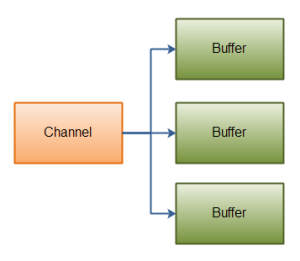
ByteBuffer header = ByteBuffer.allocate(128); ByteBuffer body = ByteBuffer.allocate(1024); ByteBuffer[] bufferArray = { header, body }; channel.read(bufferArray);
- read()方法按照buffer在数组中的顺序将从channel中读取的数据写入到buffer,当一个buffer被写满后,channel紧接着向另一个buffer中写。
- Scattering Reads在移动下一个buffer前,必须填满当前的buffer,这也意味着它不适用于动态消息(消息大小不固定)。
- 聚集(gather)写入:将多个Buffer中的数据“聚集(gather)”后发送到Channel;
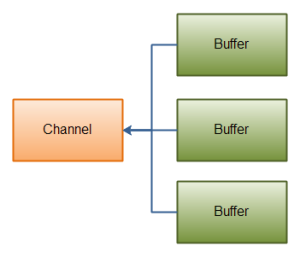
ByteBuffer header = ByteBuffer.allocate(128); ByteBuffer body = ByteBuffer.allocate(1024); //write data into buffers ByteBuffer[] bufferArray = { header, body }; channel.write(bufferArray);
- write()方法会按照buffer在数组中的顺序,将数据写入到channel,注意只有position和limit之间的数据才会被写入。
- 与Scattering Reads相反,Gathering Writes能较好的处理动态消息。【???】
Channel to Channel Transfers
在Java NIO中,如果两个通道中有一个是“FileChannel”,则可以直接将数据从一个channel传输到另外一个channel。
- “FileChannel.transferTo()”:将数据从FileChannel传输到其他的channel中;
RandomAccessFile fromFile = new RandomAccessFile("fromFile.txt", "rw"); FileChannel fromChannel = fromFile.getChannel(); RandomAccessFile toFile = new RandomAccessFile("toFile.txt", "rw"); FileChannel toChannel = toFile.getChannel(); long position = 0; long count = fromChannel.size(); fromChannel.transferTo(position, count, toChannel);
- 在SoketChannel的实现中,SocketChannel只会传输此刻准备好的数据(可能不足count字节)。因此,SocketChannel可能不会将请求的所有数据(count个字节)全部传输到FileChannel中。
- “FileChannel.transferFrom()”:将数据从源通道传输到FileChannel中;
RandomAccessFile fromFile = new RandomAccessFile("fromFile.txt", "rw"); FileChannel fromChannel = fromFile.getChannel(); RandomAccessFile toFile = new RandomAccessFile("toFile.txt", "rw"); FileChannel toChannel = toFile.getChannel(); long position = 0; long count = fromChannel.size(); toChannel.transferFrom(position, count, fromChannel);
- SocketChannel会一直传输数据直到目标buffer被填满。
常用Channel
FileChannel
FileChannel是一个连接到文件的通道。可以通过文件通道读写文件。
- FileChannel无法设置为非阻塞模式,它总是运行在阻塞模式下。
- 打开FileChannel:
- 无法直接打开一个FileChannel,需要通过使用一个“InputStream”、“OutputStream”或“RandomAccessFile”来获取一个FileChannel实例
RandomAccessFile aFile = new RandomAccessFile("data/nio-data.txt", "rw"); FileChannel inChannel = aFile.getChannel();
- 从FileChannel读取数据:
- 调用多个read()方法之一从FileChannel中读取数据。
ByteBuffer buf = ByteBuffer.allocate(48); int bytesRead = inChannel.read(buf);
- 向FileChannel写数据:
- 调用write()方法向FileChannel中写入数据。
- FileChannel.write()是在while循环中调用的。因为无法保证write()方法一次能向FileChannel写入多少字节,因此需要重复调用write()方法,直到Buffer中已经没有尚未写入通道的字节。
String newData = "New String to write to file..." + System.currentTimeMillis(); ByteBuffer buf = ByteBuffer.allocate(48); buf.clear(); buf.put(newData.getBytes()); buf.flip(); while(buf.hasRemaining()) { channel.write(buf); }
- 关闭FileChannel:
- 用完FileChannel后必须将其关闭。
channel.close();
方法:
- “position()”:通过调用“position()”方法获取FileChannel的当前位置;通过调用“position(long pos)”方法设置FileChannel的当前位置。
long pos = channel.position(); // 获取位置 channel.position(pos +123); // 设置位置
- “size()”:返回该实例所关联文件的大小。
long fileSize = channel.size();
- “truncate()”:截取一个文件。截取文件时,文件将中指定长度后面的部分将被删除。
channel.truncate(1024); // 截取文件的前1024个字节
- “force()”:将通道里尚未写入磁盘的数据强制写到磁盘上。
- (出于性能方面的考虑,操作系统会将数据缓存在内存中,所以无法保证写入到FileChannel里的数据一定会即时写到磁盘上。要保证这一点,需要调用force()方法。)
- force()方法有一个boolean类型的参数,指明是否同时将文件元数据(权限信息等)写到磁盘上。
channel.force(true);
DatagramChannel
DatagramChannel是一个能收发UDP包的通道。
- 因为UDP是无连接的网络协议,所以不能像其它通道那样读取和写入。
- 它发送和接收的是数据包。
- 打开 DatagramChannel:
DatagramChannel channel = DatagramChannel.open(); channel.socket().bind(new InetSocketAddress(9999));
- 接收数据:通过receive()方法从DatagramChannel接收数据。
- receive()方法会将接收到的数据包内容复制到指定的Buffer. 如果Buffer容不下收到的数据,多出的数据将被丢弃。
ByteBuffer buf = ByteBuffer.allocate(48); buf.clear(); channel.receive(buf);
- 发送数据:通过send()方法从DatagramChannel发送数据。
- 不会通知你发出的数据包是否已收到,因为UDP在数据传送方面没有任何保证。
String newData = "New String to write to file..." + System.currentTimeMillis(); ByteBuffer buf = ByteBuffer.allocate(48); buf.clear(); buf.put(newData.getBytes()); buf.flip(); int bytesSent = channel.send(buf, new InetSocketAddress("jenkov.com", 80));
- 以上例子:发送一串字符到”jenkov.com”服务器的UDP端口80,但因为服务端并没有监控这个端口,所以什么也不会发生。
- 连接到特定的地址:可以将DatagramChannel“连接”到网络中的特定地址的。
- 由于UDP是无连接的,连接到特定地址并不会像TCP通道那样创建一个真正的连接。而是锁住DatagramChannel,让其只能从特定地址收发数据。
channel.connect(new InetSocketAddress("jenkov.com", 80));
- 当连接后,也可以使用read()和write()方法,就像在用传统的通道一样。只是在数据传送方面没有任何保证。
int bytesRead = channel.read(buf); int bytesWritten = channel.write(but);
SocketChannel
SocketChannel是一个连接到TCP网络套接字的通道。可以通过以下2种方式创建SocketChannel:
- 打开一个SocketChannel并连接到互联网上的某台服务器。
- 一个新连接到达ServerSocketChannel时,会创建一个SocketChannel。
- 打开 SocketChannel:
SocketChannel socketChannel = SocketChannel.open(); socketChannel.connect(new InetSocketAddress("http://jenkov.com", 80));
- 关闭 SocketChannel:
socketChannel.close();
- 从 SocketChannel 读取数据:调用read()方法之一
- 首先,分配一个Buffer。从SocketChannel读取到的数据将会放到这个Buffer中。
- 然后,调用SocketChannel.read()。该方法将数据从SocketChannel 读到Buffer中。read()方法返回的int值表示读了多少字节进Buffer里。如果返回的是-1,表示已经读到了流的末尾(连接关闭了)。
ByteBuffer buf = ByteBuffer.allocate(48); int bytesRead = socketChannel.read(buf);
- 写入 SocketChannel:调用write()方法
String newData = "New String to write to file..." + System.currentTimeMillis(); ByteBuffer buf = ByteBuffer.allocate(48); buf.clear(); buf.put(newData.getBytes()); buf.flip(); while(buf.hasRemaining()) { channel.write(buf); }
- 注意SocketChannel.write()方法的调用是在一个while循环中的。Write()方法无法保证能写多少字节到SocketChannel。所以,我们重复调用write()直到Buffer没有要写的字节为止。
非阻塞模式
可以设置 SocketChannel 为非阻塞模式(non-blocking mode)。设置之后,就可以在异步模式下调用“connect()”,“read()”和“write()”了。
- connect():
- 如果SocketChannel在非阻塞模式下,此时调用connect(),该方法可能在连接建立之前就返回了。为了确定连接是否建立,可以调用“finishConnect()”的方法。如下:
socketChannel.configureBlocking(false); socketChannel.connect(new InetSocketAddress("http://jenkov.com", 80)); while(!socketChannel.finishConnect() ){ //wait, or do something else... }
- write():
- 非阻塞模式下,write()方法在尚未写出任何内容时可能就返回了。所以需要在循环中调用write()。
- read():
- 非阻塞模式下,read()方法在尚未读取到任何数据时可能就返回了。所以需要关注它的int返回值,它会告诉你读取了多少字节。
- 非阻塞模式与选择器:
- 非阻塞模式与选择器(Selector)搭配会工作的更好,通过将一或多个SocketChannel注册到Selector,可以询问选择器哪个通道已经准备好了读取、写入等。Selector与SocketChannel的搭配使用会在后面详讲。
ServerSocketChannel
Java NIO中的 ServerSocketChannel 是一个可以监听新进来的TCP连接的通道, 就像标准IO中的ServerSocket一样。
如:
ServerSocketChannel serverSocketChannel = ServerSocketChannel.open();
serverSocketChannel.socket().bind(new InetSocketAddress(9999));
while(true)
{
SocketChannel socketChannel = serverSocketChannel.accept();
// do something with socketChannel...
}
- 打开 ServerSocketChannel:通过调用 ServerSocketChannel.open() 方法来打开ServerSocketChannel;
ServerSocketChannel serverSocketChannel = ServerSocketChannel.open();
- 关闭 ServerSocketChannel:通过调用 ServerSocketChannel.close() 方法来关闭ServerSocketChannel;
serverSocketChannel.close();
- 监听新进来的连接:通过 ServerSocketChannel.accept() 方法监听新进来的连接。
- 当 accept()方法返回的时候,它返回一个包含新进来的连接的 SocketChannel。因此, accept()方法会一直阻塞到有新连接到达。
- (通常不会仅仅只监听一个连接,在while循环中调用 accept()方法)
while(true) { SocketChannel socketChannel = serverSocketChannel.accept(); //do something with socketChannel... }
非阻塞模式
ServerSocketChannel可以设置成非阻塞模式。在非阻塞模式下,accept() 方法会立刻返回,如果还没有新进来的连接,返回的将是null。因此,需要检查返回的SocketChannel是否是null.如:
ServerSocketChannel serverSocketChannel = ServerSocketChannel.open();
serverSocketChannel.socket().bind(new InetSocketAddress(9999));
serverSocketChannel.configureBlocking(false);
while(true)
{
SocketChannel socketChannel = serverSocketChannel.accept();
if(socketChannel != null)
{
//do something with socketChannel...
}
}
Java NIO非阻塞式服务器
【见:W3C:Java NIO中文版 的 Java NIO非阻塞式服务器】
其他
Path
【见:核心技术Ⅱ:I/O#Path】
Files
【见:核心技术Ⅱ:I/O#Files】
Pipe
Java NIO 管道是两个线程之间的单向数据连接:Pipe有一个“source”通道和一个“sink”通道。数据会被写到“sink”通道,从“source”通道读取。
- 创建管道:通过“Pipe.open()”方法打开管道;
Pipe pipe = Pipe.open();
- 向管道写数据:
- 要向管道写数据,需要访问sink通道“SinkChannel”;
Pipe.SinkChannel sinkChannel = pipe.sink();
- 通过调用“SinkChannel”的“write()”方法,将数据写入SinkChannel:
String newData = "New String to write to file..." + System.currentTimeMillis(); ByteBuffer buf = ByteBuffer.allocate(48); buf.clear(); buf.put(newData.getBytes()); buf.flip(); while(buf.hasRemaining()) { sinkChannel.write(buf); }
- 要向管道写数据,需要访问sink通道“SinkChannel”;
- 从管道读取数据:
- 从读取管道的数据,需要访问source通道“SourceChannel”:
Pipe.SourceChannel sourceChannel = pipe.source();
- 调用source通道的“read()”方法来读取数据:
ByteBuffer buf = ByteBuffer.allocate(48); int bytesRead = sourceChannel.read(buf);
- 从读取管道的数据,需要访问source通道“SourceChannel”:
AsynchronousFileChannel
AsynchronousFileChannel可以异步读取数据和将数据写入文件。
- 创建AsynchronousFileChannel:通过静态方法“open()”创建一个“AsynchronousFileChannel”:
Path path = Paths.get("data/test.xml"); AsynchronousFileChannel fileChannel = AsynchronousFileChannel.open(path,StandardOpenOption.READ);
- 第二个参数是一个或多个打开的选项:“StandardOpenOption.READ”用于读取而打开文件。【见:核心技术Ⅱ:I/O#复制、移动和删除文件】
- 阅读数据:通过两种方式从“AsynchronousFileChannel”读取数据;
- 通过“Future”读取数据:调用“read()”方法获得“Future”对象:
- 即使读操作尚未完成,“read()”方法也会立即返回。
AsynchronousFileChannel fileChannel = AsynchronousFileChannel.open(path, StandardOpenOption.READ); ByteBuffer buffer = ByteBuffer.allocate(1024); long position = 0; Future<Integer> operation = fileChannel.read(buffer, position); while(!operation.isDone()); buffer.flip(); byte[] data = new byte[buffer.limit()]; buffer.get(data); System.out.println(new String(data)); buffer.clear();
- 通过“CompletionHandler”读取数据:
fileChannel.read(buffer, position, buffer, new CompletionHandler<Integer, ByteBuffer>() { @Override public void completed(Integer result, ByteBuffer attachment) { System.out.println("result = " + result); attachment.flip(); byte[] data = new byte[attachment.limit()]; attachment.get(data); System.out.println(new String(data)); attachment.clear(); } @Override public void failed(Throwable exc, ByteBuffer attachment) { } });
- 通过“Future”读取数据:调用“read()”方法获得“Future”对象:
- 写入数据:通过两种方式将数据写入“AsynchronousFileChannel”:
- 确认path指向一个存在的路径:
if(!Files.exists(path)){ Files.createFile(path); }
- 通过“Future”写入数据:
Path path = Paths.get("data/test-write.txt"); if(!Files.exists(path)){ Files.createFile(path); } AsynchronousFileChannel fileChannel = AsynchronousFileChannel.open(path, StandardOpenOption.WRITE); ByteBuffer buffer = ByteBuffer.allocate(1024); long position = 0; buffer.put("test data".getBytes()); buffer.flip(); Future<Integer> operation = fileChannel.write(buffer, position); buffer.clear(); while(!operation.isDone()); System.out.println("Write done");
- 通过“CompletionHandler”写入数据:
Path path = Paths.get("data/test-write.txt"); if(!Files.exists(path)){ Files.createFile(path); } AsynchronousFileChannel fileChannel = AsynchronousFileChannel.open(path, StandardOpenOption.WRITE); ByteBuffer buffer = ByteBuffer.allocate(1024); long position = 0; buffer.put("test data".getBytes()); buffer.flip(); fileChannel.write(buffer, position, buffer, new CompletionHandler<Integer, ByteBuffer>() { @Override public void completed(Integer result, ByteBuffer attachment) { System.out.println("bytes written: " + result); } @Override public void failed(Throwable exc, ByteBuffer attachment) { System.out.println("Write failed"); exc.printStackTrace(); } });
- 确认path指向一个存在的路径:



